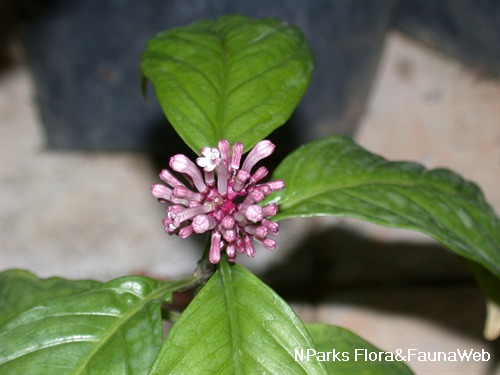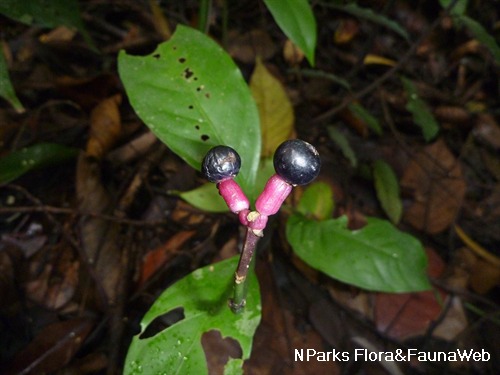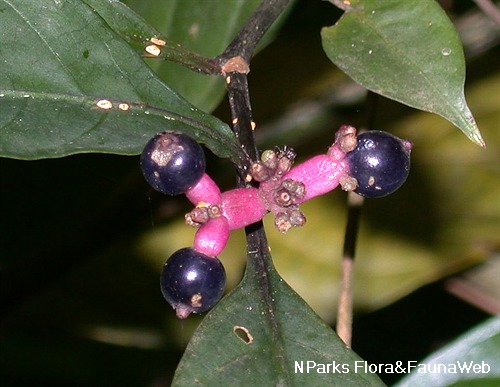
Back
Chassalia curviflora (Wall.) Thwaites
| Family Name: | Rubiaceae |
| Synonyms: | Psychotria curviflora Wall. |
Name
Classifications and Characteristics
| Plant Division | Angiosperms (Flowering Seed Plants) (Dicotyledon) |
|---|---|
| Plant Growth Form | Tree (Shrubby (1m-5m)), Shrub |
| Lifespan (in Singapore) | Perennial |
| Mode of Nutrition | Autotrophic |
| Maximum Height | 2 m |
Biogeography
| Native Distribution | India, Bangladesh, Sri Lanka, East Himalaya, China, Andaman and Nicobar Islands, Myanmar, Vietnam, Thailand, Peninsular Malaysia, Singapore, Borneo, Sumatra, Philippines, Java and Lesser Sunda Islands. |
|---|---|
| Native Habitat | Terrestrial (Primary Rainforest, Freshwater Swamp Forest) |
| Preferred Climate Zone | Tropical, Sub-Tropical / Monsoonal |
| Local Conservation Status | Native to Singapore (Vulnerable (VU)) |
Description and Ethnobotany
| Growth Form | It is a small shrub or tree up to 2 m tall. |
|---|---|
| Foliage | Its opposite, stalked leaves have leaf blades that are elliptic to inverted lance-shaped, and 6-20 by 2.5-7 cm. |
| Flowers | Its flower clusters are 3-5 cm long and develop at the tip of branches. Its white flower petals are 1.5-2 cm long, on a curved floral tube. |
| Fruit | Its 2-seeded fruits are ellipsoid or round, black, and 5-6 mm wide. |
| Habitat | It grows in hill to lowland forests and freshwater swamp forests. |
| Associated Fauna | Its flowers are pollinated by insects, and its fruits are eaten by birds. |
| Cultivation | It can be propagated by seeds or stem cuttings. |
Landscaping Features
| Landscaping | It can be utilised as an ornamental shrub for shaded areas. |
|---|---|
| Desirable Plant Features | Ornamental Flowers, Ornamental Fruits |
| Landscape Uses | General, Parks & Gardens, Small Gardens |
| Thematic Landscaping | Naturalistic Garden |
Fauna, Pollination and Dispersal
| Fauna Pollination Dispersal Associated Fauna | Bird-Attracting |
|---|---|
| Pollination Method(s) | Biotic (Fauna) |
| Seed or Spore Dispersal | Biotic (Fauna) |
Plant Care and Propagation
| Light Preference | Semi-Shade, Full Shade |
|---|---|
| Water Preference | Moderate Water |
| Plant Growth Rate | Moderate |
| Rootzone Tolerance | Moist Soils, Well-Drained Soils, Fertile Loamy Soils |
Foliar
| Foliage Retention | Evergreen |
|---|---|
| Mature Foliage Colour(s) | Green |
| Mature Foliage Texture(s) | Leathery |
| Prominent Young Flush Colour(s) | Green |
| Young Flush Texture(s) | Leathery |
| Foliar Type | Simple / Unifoliate |
| Foliar Arrangement Along Stem | Opposite |
| Foliar Attachment to Stem | Petiolate |
| Foliar Shape(s) | Non-Palm Foliage (Elliptical, Oblanceolate) |
| Foliar Venation | Pinnate / Net |
| Foliar Margin | Entire |
Floral (Angiosperm)
| Flower & Plant Sexuality | Bisexual Flowers |
| Flower Colour(s) | White |
|---|---|
| Flower Grouping | Cluster / Inflorescence |
| Flower Location | Terminal |
| Flower Symmetry | Radial |
Fruit, Seed and Spore
| Mature Fruit Colour(s) | Black |
|---|---|
| Fruit Classification | Simple Fruit |
| Fruit Type | Fleshy Fruit , Non-Accessory Fruit |
Image Repository
Others
| Master ID | 31244 |
|---|---|
| Species ID | 5639 |
| Flora Disclaimer | The information in this website has been compiled from reliable sources, such as reference works on medicinal plants. It is not a substitute for medical advice or treatment and NParks does not purport to provide any medical advice. Readers should always consult his/her physician before using or consuming a plant for medicinal purposes. |




